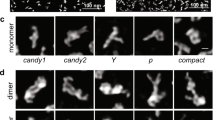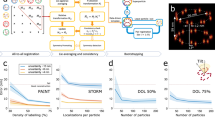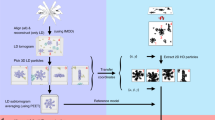Abstract
Very often, the positions of flexible domains within macromolecules as well as within macromolecular complexes cannot be determined by standard structural biology methods. To overcome this problem, we developed a method that uses probabilistic data analysis to combine single-molecule measurements with X-ray crystallography data. The method determines not only the most likely position of a fluorescent dye molecule attached to the domain but also the complete three-dimensional probability distribution depicting the experimental uncertainty. With this approach, single-pair fluorescence resonance energy transfer measurements can now be used as a quantitative tool for investigating the position and dynamics of flexible domains within macromolecular complexes. We applied this method to find the position of the 5′ end of the nascent RNA exiting transcription elongation complexes of yeast (Saccharomyces cerevisiae) RNA polymerase II and studied the influence of transcription factor IIB on the position of the RNA.
This is a preview of subscription content, access via your institution
Access options
Subscribe to this journal
Receive 12 print issues and online access
$259.00 per year
only $21.58 per issue
Buy this article
- Purchase on Springer Link
- Instant access to full article PDF
Prices may be subject to local taxes which are calculated during checkout





Similar content being viewed by others
References
Ramakrishnan, V. Ribosome structure and the mechanism of translation. Cell 108, 557–572 (2002).
Singleton, M.R. et al. Crystal structure of RecBCD enzyme reveals a machine for processing DNA breaks. Nature 432, 187–193 (2004).
Cramer, P., Bushnell, D.A. & Kornberg, R.D. Structural basis of transcription: RNA polymerase II at 2.8 angstrom resolution. Science 292, 1863–1876 (2001).
Vassylyev, D.G. et al. Structural basis for transcription elongation by bacterial RNA polymerase. Nature 448, 157–162 (2007).
Weiss, S. Fluorescence spectroscopy of single biomolecules. Science 283, 1676–1683 (1999).
Forster, T. Zwischenmolekulare Energiewanderung und Fluoreszenz. Ann. Phys-Berlin 437, 55–75 (1948).
Bregeon, D. et al. Transcriptional mutagenesis induced by uracil and 8-oxoguanine in Escherichia coli. Mol. Cell 12, 959–970 (2003).
Kapanidis, A.N. et al. Initial transcription by RNA polymerase proceeds through a DNA-scrunching mechanism. Science 314, 1144–1147 (2006).
Dale, R.E., Eisinger, J. & Blumberg, W.E. The orientational freedom of molecular probes. The orientation factor in intramolecular energy transfer. Biophys. J. 26, 161–193 (1979).
Myong, S. et al. Spring-loaded mechanism of DNA unwinding by hepatitis C virus NS3 helicase. Science 317, 513–516 (2007).
Kapanidis, A.N. et al. Fluorescence-aided molecule sorting: analysis of structure and interactions by alternating-laser excitation of single molecules. Proc. Natl. Acad. Sci. USA 101, 8936–8941 (2004).
Rothwell, P.J. et al. Multiparameter single-molecule fluorescence spectroscopy reveals heterogeneity of HIV-1 reverse transcriptase:primer/template complexes. Proc. Natl. Acad. Sci. USA 100, 1655–1660 (2003).
Rasnik, I. et al. DNA-binding orientation and domain conformation of the E. coli Rep helicase monomer bound to a partial duplex junction: single-molecule studies of fluorescently labeled enzymes. J. Mol. Biol. 336, 395–408 (2004).
Andrecka, J. et al. Single-molecule tracking of mRNA exiting from RNA polymerase II. Proc. Natl. Acad. Sci. USA 105, 135–140 (2008).
Schröder, G.F. & Grubmüller, H. FRETsg: biomolecular structure model building from multiple FRET experiments. Comput. Phys. Commun. 158, 150–157 (2004).
Margittai, M. et al. Single-molecule fluorescence resonance energy transfer reveals a dynamic equilibrium between closed and open conformations of syntaxin 1. Proc. Natl. Acad. Sci. USA 100, 15516–15521 (2003).
Zhuang, X. et al. Correlating structural dynamics and function in single ribozyme molecules. Science 296, 1473–1476 (2002).
McKinney, S.A. et al. Structural dynamics of individual Holliday junctions. Nat. Struct. Biol. 10, 93–97 (2003).
Diez, M. et al. Proton-powered subunit rotation in single membrane-bound F0F1-ATP synthase. Nat. Struct. Mol. Biol. 11, 135–141 (2004).
Lewis, R. et al. Conformational changes of a Swi2/Snf2 ATPase during its mechano-chemical cycle. Nucleic Acids Res. 36, 1881–1890 (2008).
Sivia, D.S. Data Analysis: A Bayesian Tutorial Ch. 1–3, 3–77 (Clarendon Press, Oxford, UK, 1996).
Alber, F. et al. Determining the architectures of macromolecular assemblies. Nature 450, 683–694 (2007).
Medintz, I.L. et al. A fluorescence resonance energy transfer-derived structure of a quantum dot-protein bioconjugate nanoassembly. Proc. Natl. Acad. Sci. USA 101, 9612–9617 (2004).
Radman-Livaja, M. et al. Architecture of recombination intermediates visualized by in-gel FRET of lambda integrase-Holliday junction-arm DNA complexes. Proc. Natl. Acad. Sci. USA 102, 3913–3920 (2005).
Sun, X. et al. Architecture of the 99 bp DNA-six-protein regulatory complex of the lambda att site. Mol. Cell 24, 569–580 (2006).
Mekler, V. et al. Structural organization of bacterial RNA polymerase holoenzyme and the RNA polymerase-promoter open complex. Cell 108, 599–614 (2002).
Jung, C. et al. Simultaneous measurement of orientational and spectral dynamics of single molecules in nanostructured host-guest materials. J. Am. Chem. Soc. 129, 5570–5579 (2007).
Toprak, E. et al. Defocused orientation and position imaging (DOPI) of myosin V. Proc. Natl. Acad. Sci. USA 103, 6495–6499 (2006).
Ujvari, A. & Luse, D.S. RNA emerging from the active site of RNA polymerase II interacts with the Rpb7 subunit. Nat. Struct. Mol. Biol. 13, 49–54 (2006).
Bushnell, D.A. et al. Structural basis of transcription: an RNA polymerase II-TFIIB cocrystal at 4.5 angstroms. Science 303, 983–988 (2004).
Pal, M., Ponticelli, A.S. & Luse, D.S. The role of the transcription bubble and TFIIB in promoter clearance by RNA polymerase II. Mol. Cell 19, 101–110 (2005).
Jasiak, A.J. et al. Genome-associated RNA polymerase II includes the dissociable RPB4/7 subcomplex. J. Biol. Chem. 283, 26423–26427 (2008).
Runner, V.M., Podolny, V. & Buratowski, S. The Rpb4 subunit of RNA polymerase II contributes to cotranscriptional recruitment of 3′ processing factors. Mol. Cell. Biol. 28, 1883–1891 (2008).
Kettenberger, H., Armache, K.J. & Cramer, P. Complete RNA polymerase II elongation complex structure and its interactions with NTP and TFIIS. Mol. Cell 16, 955–965 (2004).
Acknowledgements
We would like to thank V. Dose, D.C. Lamb and C. Bräuchle for discussions as well as S. Waszak for help with the programming. The work was supported by the Deutsche Forschungsgemeinschaft, Sonderforschungsbereich 646, the Center for Nanoscience and the Nanosystems Initiative Munich.
Author information
Authors and Affiliations
Contributions
A.M. performed calculations, designed analysis, wrote the analysis program and wrote the paper; J.A. performed experiments and wrote the paper; F.B. provided reagents; A.J. performed experiments and provided reagents; P.C. and J.M. designed experiments and wrote the paper.
Corresponding author
Supplementary information
Supplementary Text and Figures
Supplementary Figures 1–8, Supplementary Table 1, Supplementary Methods (PDF 3098 kb)
Supplementary Data
XPLOR files for the ADM position probability density for the position of RNA 1 (with and without structural constraints) and RNA 29 (with and without TFIIB) (ZIP 2250 kb)
Supplementary Software
Compiled Matlab software for NPS including detailed instructions (ZIP 758 kb)
Rights and permissions
About this article
Cite this article
Muschielok, A., Andrecka, J., Jawhari, A. et al. A nano-positioning system for macromolecular structural analysis. Nat Methods 5, 965–971 (2008). https://doi.org/10.1038/nmeth.1259
Received:
Accepted:
Published:
Issue Date:
DOI: https://doi.org/10.1038/nmeth.1259
This article is cited by
-
Reliability and accuracy of single-molecule FRET studies for characterization of structural dynamics and distances in proteins
Nature Methods (2023)
-
Structural dynamics of DNA strand break sensing by PARP-1 at a single-molecule level
Nature Communications (2022)
-
Automated and optimally FRET-assisted structural modeling
Nature Communications (2020)
-
Resolving dynamics and function of transient states in single enzyme molecules
Nature Communications (2020)
-
Nanofiber based displacement sensor
Applied Physics B (2020)



